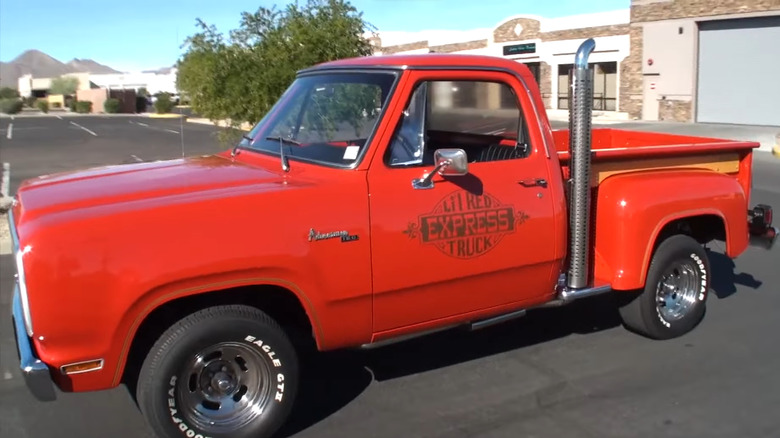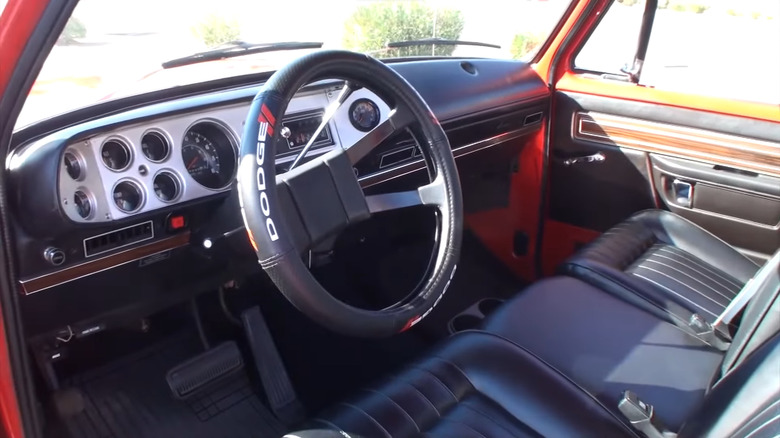Here's What Makes The Dodge Li'l Red Express Truck So Special
The OPEC oil crisis in 1973 profoundly impacted the car industry (via NPR). Gasoline rationing forced automakers to shift from land yachts to more efficient vehicles. Events around this same time, such as new emissions laws and tighter safety standards, rattled muscle car production as well. Amid the chaos, Dodge discovered that anything over 6,100 pounds was exempt from the new rules, so they cleverly took advantage of the non-eco-friendly loophole, according to MotorTrend.
In 1976 Dodge unveiled its new set of "Adult Toys." Despite the bawdy nomenclature (mind out of the gutter, please), MotorTrend reports this campaign featured four-wheeled American steel with wild names like Warlock, Macho Power Wagon, and Ramcharger. Each one had bold, over-the-top looks, as though a Dodge ad exec noticed the popularity of Hot Wheels and had an ah-ha moment. The "Adult Toys" that came out of this line were nothing short of beastly, with the king being the 1978 Li'l Red Express (LRE), yet another classic muscle car worth owning from Dodge.
According to Chrysler engineer Tom Hoover, Li'l Red Express was considered by many as "The Last American Hot Rod," a claim it backed up. A contemporaneous issue of Car and Driver found by MotorTrend said it reached 100 mph in 19.9 seconds, the quickest of the vehicles it tested. Hot Rod magazine said it ran the quarter mile in 14.7 seconds, beating out a Chevy Camaro Z28 in a head-to-head race (via Hagerty).
I am Dodge, hear me roar
The LREs roar was just as bad as its bite. A 1976 issue of Car and Driver magazine noted that at 110 mph cruising speed, the interior noise level hit 94 decibels. That's about the same volume as sitting next to a lawn mower. All that noise came from the very things that caught everyone's attention first — the beautiful double chrome exhaust stacks just a few feet away from passengers' heads. The LRE was so loud, Dodge couldn't sell it in several states because it exceeded noise restrictions.
And that's where the Midnite Express (ME) comes into the picture. Nearly a replica of the Li'l Red Express, the very rare ME was painted black instead and created for sale in states that didn't allow the LRE, according to MotorBiscuit. It was manufactured for a single year, and only about 200 were produced.
Since "Smokey and the Bandit" was a huge hit at the box office around the same time, it's not a reach to say Dodge was hoping to ride the cachet of Burt Reynolds, Sally Field, and Jerry Reed. The Li'l Red Express was painted in a color Dodge dubbed Bright Canyon Red with chrome exterior trim that twinkled atop distinctive slotted 7-inch wheels in the front and slightly wider 8-inch wheels in the back, according to MotorTrend. The Utiline stepside cargo bed's exterior came with real oak siding, while the deck was lined with pine (via MotorTrend).
The Li'l Red Express was the last American factory hot rod
The LRE had a 115-inch D150 Adventurer chassis with power steering and a special three-speed automatic transmission. You could get red bucket seats (with convenient center storage) or a bench seat in either red or black. Under the hood lay the heart of the beast — a 360-cubic-inch (5.9-liter) police-spec V-8 with a four-barrel carburetor and cold-air induction (car tech that is currently banned in some states). It produced 225 horsepower and 295 pound-feet of torque (via MotorTrend).
The MSRP on the LRE in 1978 was "almost $7,000." Dodge initially planned on only making 2,000, but demand was so high it made an additional 188. It was given the go-ahead for production in '79, but the government had since caught on to Dodge's tricks and raised the gross vehicle weight limit to 8,000 pounds, which forced Dodge to put in a catalytic converter, improve exhaust emissions, and use unleaded gasoline for all '79 models. A telling sign of these changes was seen on the speedometer, where the maximum speed was dialed down from 100 mph to 85. A few cosmetic changes included adding quad-headlights and broader front wheels, according to MotorTrend.
Dodge raised the price to $7,500, but despite selling what many considered a downgrade from the original, it still couldn't produce them fast enough — until a second oil crisis in 1979. Dodge only made 5,118 before the Li'l Red Express finally came to a grinding halt.

